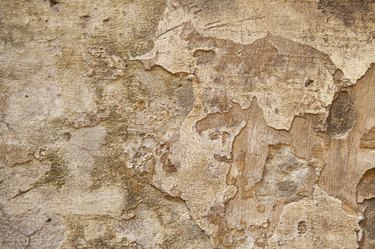Things You'll Need
Hammer
Paint scraper
Muriatic acid
Cloth
Plastic wrap
Wide tape

Plaster is a popular choice for covering walls, as it is easy to apply, durable and gives a smooth finish, making it very easy to paint or paper over. However, the hard-wearing nature of plaster means that once it is applied to a surface and allowed to cure, it can be incredibly difficult to remove. Removal of plaster from concrete block walls is, therefore, an exercise in scraping, dissolving and, above all, patience.
Step 1
Tap the plaster firmly using a hammer, to break the surface. This will cause the plaster to crack and begin to flake off. Scrape away as much of the cracked plaster as possible using a paint scraper or other wide, flat tool.
Video of the Day
Step 2
Put on safety gloves. Pour muriatic acid onto an old cloth until it is soaked. Press the cloth against the remnants of plaster on the wall. Cover the cloth in a layer of plastic, such as the plastic used for wrapping sandwiches. Tape the plastic firmly in place against the wall, to keep the moisture in and prevent the acid from evaporating.
Step 3
Wait 24 hours. Peel back the plastic and cloth from the wall. Scrape away the dissolved or partly dissolved plaster using the paint scraper. If any sections of plaster will still not come away, moisten the area with more muriatic acid, dampen the cloth and re-affix it to the wall. Wait another 24 hours then scrape away the plaster again.
Tip
If large sections of the plaster will not dissolve in the acid, tap them firmly with the hammer, then try scraping them away again. Sometimes the plaster becomes weakened by the actions of the acid, and the hammer can then break it apart enough to scrape away.
Warning
Working with acids is a highly dangerous procedure. Always wear safety gloves and safety goggles when handling them, as splashes can lead to severe burns or even blindness. Store acids in a cool, dry place well away from children and animals.
Video of the Day